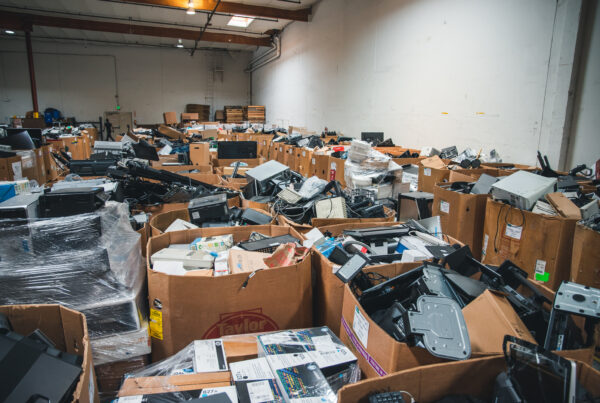According to Capterra, nearly 29% of U.S. small and midsize businesses engage in improper IT hardware disposal practices. It’s a risky gamble when navigating complicated e-waste regulations. These organizations face potential fines reaching $37,500 (sometimes more) per day per violation. What seems like a simple equipment upgrade then turns into a compliance nightmare. With e-waste on the rise, the stakes keep getting higher. The WHO reports that 62 million tons of e-waste were discarded globally in 2022, triggering stricter e-waste regulatory oversight and enforcement.
Choosing the wrong ITAD vendor exposes your organization to devastating legal penalties. Catastrophic data breaches and compliance failures destroy a company’s reputation. However, asking the right questions upfront helps you identify certified, compliant ITAD partners who safeguard both your sensitive data and your organization’s future success.
Table of Contents
- What Certifications Should ITAD Providers Have?
- How Do You Handle Industry-Specific Compliance Requirements?
- What Data Destruction Methods Do You Use?
- How Do You Track and Document the Entire Process?
- Protecting Your Organization’s Future
- Ready to ensure you meet all regulatory requirements when you get rid of technology?
What Certifications Should ITAD Providers Have?
The ITAD industry operates without mandatory licensing requirements. This means ITAD is self-regulated. Any company can claim expertise without proper credentials. So it’s important to ask what certification an ITAD vendor has and make sure they can verify those certifications.
Essential Certifications That Matter
1. NAID AAA Certification represents the gold standard for data destruction services. Don’t confuse this with simple NAID membership, which requires only an annual fee. AAA Certification demands rigorous annual, unannounced audits conducted by independent Certified Protection Professionals® (CPP). These surprise inspections verify that providers actually follow documented security protocols rather than just talking about them.
2. R2 (Responsible Recycling) Certification demonstrates company-wide commitment to environmental compliance. This certification requires documented strategies for reuse, materials recovery, and proper disposal. Vendors must maintain aligned policies for managing used electronics equipment, components, and materials throughout the entire lifecycle.
3. e-Stewards Certification identifies providers adhering to the highest environmental standards globally. This program emphasizes reducing negative environmental and social impacts while ensuring electronics don’t end up in developing countries with poor environmental controls.
4. ISO Certifications provide additional quality assurance layers: ISO 14001 for environmental management systems, ISO 45001 for occupational health and safety, and ISO 9001 for quality management systems.
Watch for vendors displaying membership logos without active certification status. That’s a major red flag indicating they’re paying for marketing credibility rather than proving operational excellence. And it’s an e-waste regulation nightmare waiting to happen!
Certifications establish baseline credibility, but your organization’s unique regulatory landscape demands much deeper investigation.
How Do You Handle Industry-Specific Compliance Requirements?
Generic compliance approaches spell disaster in today’s regulatory environment. Different industries operate under distinct frameworks that impose severe financial penalties for violations—sometimes reaching millions in fines and litigation costs.
E-Waste Regulations for Sector-Specific Regulatory Landscapes
Healthcare organizations must navigate HIPAA’s stringent requirements for Protected Health Information (PHI). Every device containing patient data requires specialized handling throughout disposal. Violations trigger investigations, patient notifications, and crushing financial penalties.
Financial services firms face Gramm-Leach-Bliley Act (GLBA) mandates demanding customer information protection during IT asset disposal. Customer data must become completely unreadable and unusable before devices leave custody.
Government contractors operate under Federal Information Security Management Act (FISMA) requirements dictating specific protocols for federal information systems. These contracts include stringent data destruction clauses that can void agreements if violated.
All industries must meet NIST 800-88 standards for data sanitization—the federal baseline many sector-specific regulations reference.
Critical Verification Points
Your ITAD vendor should demonstrate deep understanding of your sector’s e-waste regulations, not just broad compliance knowledge. Verify their experience with organizations similar to yours. Request documented compliance procedures specific to your industry. Confirm their staff receives ongoing training on evolving regulatory requirements.
The wrong vendor transforms routine equipment disposal into a data breach investigation with your organization’s sensitive information at the center.
What Data Destruction Methods Do You Use?
This is a very important question for your ITAD vendor! According to UNITAR, only 22.3% of “recycled” e-waste actually reached proper facilities in 2023. The remaining 77.7% ends up in landfills or unsafe processing channels—potentially exposing your sensitive data to unauthorized access.
Hierarchy of Acceptable Methods
NIST 800-88 R1 Certified Software Overwrite represents the highest standard of data destruction. This method uses certified software to completely overwrite stored data while preserving device functionality. Organizations benefit from the most sustainable option that allows equipment reuse and remarketing.
Degaussing employs powerful magnetic forces to rearrange data structure, rendering information unreadable and disks unusable. While less sustainable than software overwrite, this method still permits limited component reuse through refurbishment processes.
Physical Destruction involves complete device shredding through mechanical force. Reserve this least sustainable option for devices that cannot undergo secure software sanitization due to age, damage, or organizational policy requirements.
Non-Negotiable Requirements
Demand 100% verification of data sanitization for every device processed. Ensure DoD and HIPAA-compliant processes regardless of your industry sector. Require removal of all identifying markings including asset tags, stickers, and corporate branding. Obtain certificates of data destruction documenting completion for each individual device.
Always ask: “What happens if a device cannot be completely sanitized?” Their answer reveals whether comprehensive security protocols exist beyond standard procedures.
How Do You Track and Document the Entire Process?
Complying with e-waste regulations hinges on detailed documentation proving proper asset handling from pickup to final disposition.
Essential Documentation Requirements
An ITAD vendor’s chain of custody protocols should include GPS-tracked transportation with multiple camera systems monitoring every movement. Serialized reporting tracks individual devices using unique identifiers and serial numbers throughout the entire lifecycle. Destruction certificates provide verified completion documentation for data sanitization procedures. And environmental impact reports demonstrate responsible disposal practices satisfying e-waste regulation requirements.
Transparency Standards
Demand real-time tracking through self-service online portals that eliminate guesswork about asset status. Quality vendors maintain audit-ready documentation accessible whenever regulatory bodies request evidence.
Comprehensive tracking protects during compliance audits, but physical security measures during transportation create equally critical protection layers.
Protecting Your Organization’s Future
Smart vendor selection protects your organization from devastating e-waste regulation compliance failures while creating positive environmental impact. The right ITAD partner safeguards sensitive data, meets regulatory requirements, and supports corporate sustainability goals simultaneously.
Don’t gamble with your organization’s reputation and financial stability. Audit your current ITAD vendor against these critical evaluation criteria. Request documentation proving certifications, compliance procedures, and industry-specific expertise.
Ready to ensure you meet all regulatory requirements when you get rid of technology?
Human-I-T’s certified ITAD experts understand the complex compliance landscape facing today’s organizations and provide comprehensive solutions that protect your data while transforming discarded technology into opportunities for those who need it most.






